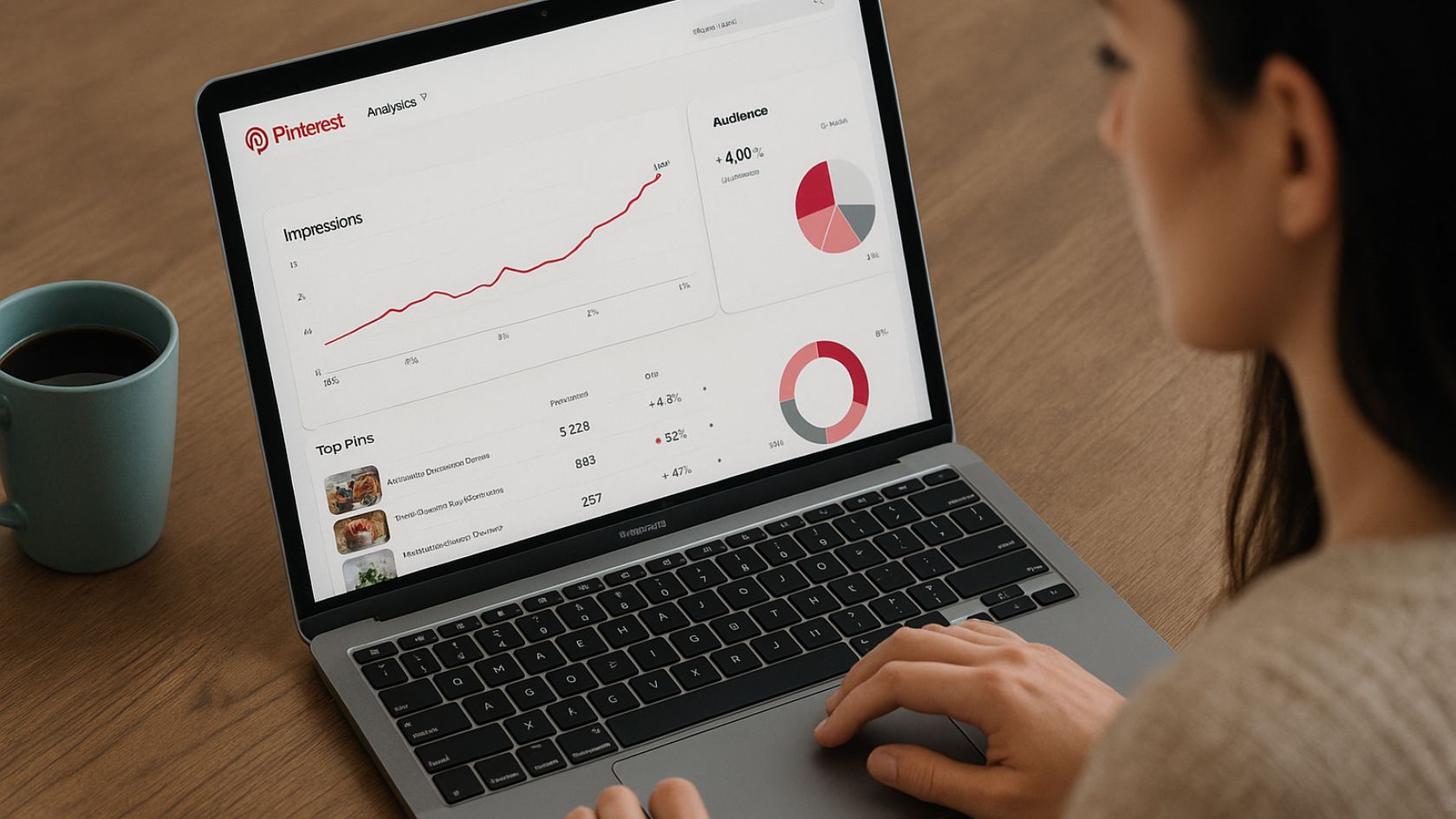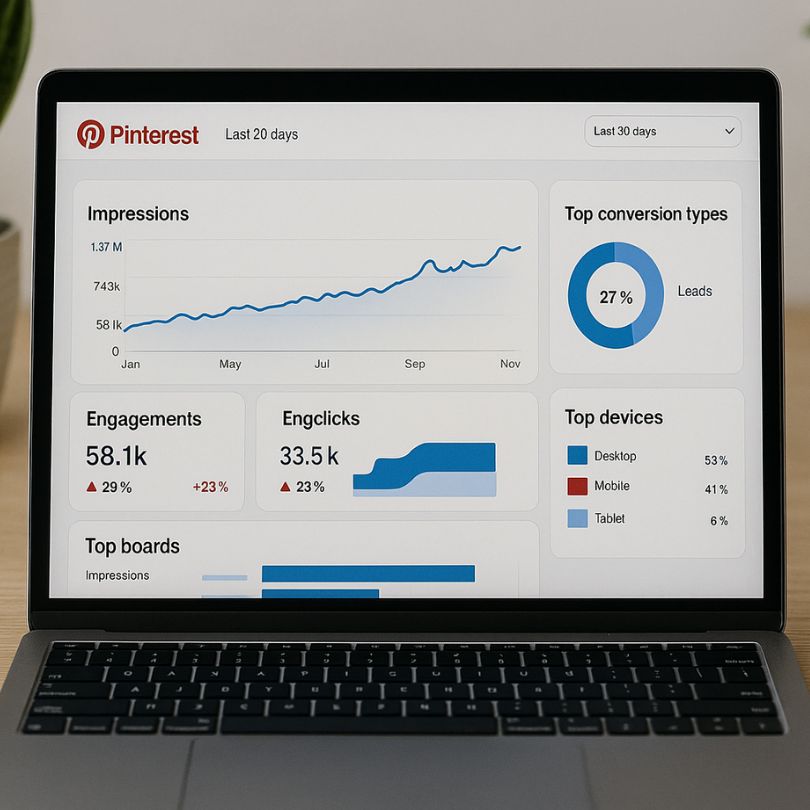
Advanced Pinterest Analytics: The Complete Playbook for Metrics, Dashboards, and ROI

Advanced Pinterest analytics help marketers and creators turn Pins into predictable growth by revealing what truly drives impressions, saves, clicks, and conversions across your funnel.
Before diving into tactics, make sure you can reliably access your reporting. The native Pinterest Analytics dashboard is the fastest way to inspect audience trends, top-performing Pins and Boards, and conversion paths when your tag is set up. We’ll build on that foundation and show you how to translate metrics into decisions that compound results month after month.
Focus keyword: Advanced Pinterest analytics
Start with a measurement framework. Define a north-star KPI (e.g., qualified outbound clicks or checkouts), supporting indicators (impressions, saves, CTR), and diagnostic metrics (Pin type, format, keywords, fresh vs. repins). This hierarchy ensures you never optimize for vanity stats at the expense of real outcomes.
Benchmark the creative and competitive landscape to set realistic targets. Study what formats (static, idea pins, video) and narratives resonate in your niche, then test new angles week over week. Third‑party ad intelligence can also inform hypotheses; for example, exploring winning hooks from tools like Anstrex InStream can inspire scroll‑stopping creatives and stronger calls to action.
Core metrics that actually matter
Not every metric deserves equal attention. Prioritize the ones that map to intent and revenue:
- Impressions: Early signal of search alignment and distribution. Rising impressions + flat clicks often means weak creative or misaligned intent.
- Saves: Indicates future intent and collection behavior. Rising saves predict downstream conversions, especially for seasonal or planning-heavy categories.
- Outbound clicks (link clicks): Strongest indicator of content-market fit on platform. Combine with CTR to isolate creative effectiveness.
- CTR (click-through rate): Helps you compare Pins with different impression volumes. Low CTR with high impressions = creative/keyword mismatch.
- Conversions: Requires a properly implemented Pinterest tag and server-side events where possible. Track add-to-carts, sign-ups, purchases.
- Cost per action (for ads): Tie spend to outcomes. Blend organic and paid learnings to accelerate winners.
Set up your data correctly (10-minute checklist)
- Confirm your domain claim: Ensures full attribution and analytics visibility.
- Install the Pinterest tag: Use Tag Manager where possible; validate with the Tag Helper. Track events like pagevisit, addtocart, signup, and checkout.
- Turn on enhanced match: Improves attribution and audience quality by matching hashed identifiers.
- Align UTM parameters: Use a consistent structure such as
utm_source=pinterest&utm_medium=social&utm_campaign={{board}}&utm_content={{pin_title}}. - Time-zone and currency: Standardize across ad account, analytics, and your store/CRM.
- Create a sandbox board: Publish test Pins first to validate formatting, titles, and links.
Keyword and content strategy driven by data
Pinterest is a visual search engine. Treat your content plan like SEO with visuals. Build a keyword set around head, body, and long‑tail queries, then map them to Boards and content series. Track impressions and CTR per keyword cluster to double down on clusters with the best click efficiency.
- Build a seed list: Start with auto-suggest, related searches, and top-performing Pins’ titles and descriptions.
- Cluster by intent: Group queries into “how‑to,” “inspiration,” and “product” buckets. Align Pin formats and CTAs accordingly.
- Publish in series: Create 3–5 angle variations for each keyword cluster to find a breakout winner quickly.
- Refresh and repost: Rework winners quarterly with new hooks, crops, and overlays to capture fresh distribution.
Dashboards that answer business questions
Acquisition dashboard
- Impressions, CTR, and outbound clicks by Pin type and by keyword cluster.
- Top 20 Pins by 7‑day click velocity (new vs. evergreen).
- Board‑level performance to identify content themes worth scaling.
Engagement dashboard
- Saves rate and save‑to‑click ratio as a proxy for future demand.
- Comments and reactions on Idea Pins and video Pins.
- Pin completion rate for video (25/50/75/100%).
Monetization dashboard
- Sessions, sign‑ups, add‑to‑carts, and purchases from Pinterest UTMs.
- Blended CAC/CPA comparing paid and organic.
- Attribution window analysis (1/7/30‑day) to find the real payback period.
Creative diagnostics
- Hook line analysis: title length, power words, and keyword placement.
- Thumbnail/crop variants and overlay styles versus CTR.
- Format effectiveness by audience segment and device.
Weekly operating cadence
- Monday: Review dashboards; select 3 hypotheses (e.g., “shorter titles lift CTR for meal‑prep”).
- Tuesday–Thursday: Produce and publish 6–9 Pins across 2–3 clusters. Label with consistent UTMs.
- Friday: Inspect 72‑hour leading indicators (impressions, CTR, saves); push early winners into ads.
- Monthly: Archive the bottom 20% of Pins; refresh the top 20% with new hooks, overlays, and aspect ratios.
Run disciplined experiments
Good experiments change one thing at a time and run long enough to collect signal. Use this rubric:
- Hypothesis: “Adding a price badge improves CTR for gift‑guide Pins.”
- Variant design: A/B two creatives only; keep title, description, and URL identical.
- Power: Aim for 1000+ impressions per variant to reduce randomness.
- Decision rule: If CTR improves ≥ 20% with stable saves rate, promote the winner across related Boards.
- Documentation: Log hypotheses and outcomes in a simple spreadsheet so the team learns and compounds.
Advanced analysis for pros
Cohorts by publish week
Group Pins by the week they were published and track click velocity across the next 8 weeks. You’ll spot which creative types decay quickly and which earn long tails (often guides and checklists). Allocate production resources toward assets with durable tails.
Funnels from save → click → sign‑up → purchase
Map each step’s conversion rate. When saves are high but clicks are low, iterate on overlays and titles. When clicks are high but sign‑ups lag, fix landing‑page relevance—match headline and hero image to the Pin’s promise.
Query‑level intent
Segment keywords into “do,” “know,” and “shop” intents. Expect higher CTR on “do” and “shop,” but higher save rates on “know.” Balance the portfolio so you’re nurturing demand today and converting it tomorrow.
Content patterns that reliably win
- Blueprints and checklists: “7‑Step Pantry Reset,” “One‑Page Wedding Timeline.” Easy to save, easy to act on.
- Before/after carousels: Visually telegraph outcomes; add “See steps” overlay to nudge clicks.
- Micro‑tutorial videos (15–30s): Fast cuts, bold captions, and a final frame CTA that mirrors landing‑page copy.
- Seasonal series: Plan 6–8 weeks ahead. Use templates so your design system stays recognizable but fresh.
SEO for Pins (titles, descriptions, and Boards)
- Titles: Front‑load the primary keyword. Keep it punchy (50–70 chars) and action‑oriented.
- Descriptions: Weave secondary keywords naturally. Add a soft CTA and relevant hashtags sparingly.
- Boards: Name Boards with clear, searchable terms. Add descriptions that explain the theme and target audience.
- Image text overlays: Use contrast and 5–7 word hooks. Ensure mobile readability.
Turning insights into revenue
Insights only matter when they change behavior. Connect analytics to production by keeping a shared backlog of ideas scored on expected impact, confidence, and effort. Each week, ship the highest‑scoring items first. Promote proven winners with modest ad budgets to accelerate learning while maintaining efficiency.
Common pitfalls to avoid
- Chasing impressions only: Optimize for CTR and clicks to keep quality traffic flowing.
- Ignoring landing pages: Maintain scent from Pin to page—same keywords, visuals, and promise.
- Over‑tagging: Don’t cram hashtags or keyword‑stuff. Natural language wins distribution and trust.
- One‑off posts: Publish in themes and series to build familiarity and compounding reach.
Conclusion
Advanced Pinterest analytics aren’t about staring at dashboards; they’re about creating a tight loop between insights and production. By prioritizing intent‑aligned keywords, testing creatives systematically, and upgrading landing‑page relevance, you’ll compound saves, clicks, and conversions over time. For deeper audience education and lead capture, consider hosting a short educational event—this guide to creating engaging webinars can help you turn Pinterest interest into subscribers and customers.